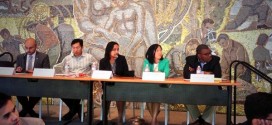By Whitney Pipkin
When the Chicago-based Asian Health Coalition began work on health initiatives in Chinatown neighborhoods, Alia Ryan said the team tried to avoid using the term “obesity” even as they tried to address it as a local problem.
She said Asian Americans and Pacific Islanders (AAPIs) in the region didn’t relate to the word, which they see as referring mostly to other American ethnicities with far higher obesity rates.
“There’s a common misconception that Asian Americans are healthy, that obesity doesn’t exist,” Ryan said. “[There is a visual aspect] of what is normally considered obese and obesity isn’t there.”
But Asian health advocates say appearances can mask the weight problems — and health-related — issues that are becoming more prevalent among AAPIs in the U.S.
“It looks like we don’t have any problems, which is not true,” said Dr. Ho Luong Tran with the National Council of Asian Pacific Islander Physicians.
Just 11 percent of Asians are considered obese or having a Body Mass Index (BMI) of 30 or greater, compared to a 35-percent rate among other Americans, according to the latest National Health and Nutrition Examination Survey.
This latest survey is the first of its kind by the Centers for Disease Control and Prevention to include Asians, who now make up an estimated 5 percent of the population.
But Tran and others say the comparatively low obesity rate can be misleading, because Asians experience a higher prevalence of obesity-related diseases, such as diabetes and heart disease, at lower BMIs than other ethnicities.
Unlike other ethnicities, Asian-Americans experience an increased risk for diabetes at a BMI of 24, according to the American Diabetes Association. By the CDC survey standards, individuals at that BMI wouldn’t even be considered overweight.
“So if people wait until they’re at a 30 (BMI), we will have diabetes in our community,” said Tran.
Tran says her own sister, who is 5’4” and weighs just 110 pounds, would be considered “very skinny” by most measurements — but she has diabetes.
She says part of the risk is that Asians carry more adipose fat tissue around their middle section, which can increase their risk for cardiovascular diseases like heart failure and stroke as well as diabetes.
Tran and her council are working to raise awareness among Asians and the physicians that treat them that they could be at risk for these diseases despite their low BMIs. Tran said she also considers an Asian patient’s waist circumference in deciding whether they should be screened for certain diseases.
Tran said even treating AAPIs as one lumped-together group can present problems, as there are a diversity of health issues and predispositions among Asians. Filipino adults, for example, are 70 percent more likely to be obese as compared to the overall Asian population, according to the Office of Minority Health.
Meanwhile, Pacific Island nations have the most overweight people in the world, according to the most recent estimates by World Health Organization (WHO) that were included in a health brief on obesity among Asian Americans, Native Hawaiians and Pacific Islanders.
These differences can be true when treating Asian children as well.
A paper published about obesity among AAPI children found that Vietnamese-American children were at an elevated risk of obesity and overweightness compared to a lower risk among Chinese and Asian-Indian children.
Case Study: Children in Chicago’s Chinatown
Ryan said the Asian Health Coalition’s work in Chicago has increasingly focused on Asian youth, which is showing a higher proclivity toward obesity than the previous generation.
AAPIs have the fastest-growing rate of overweight children, according to the Asian American Network for Cancer Awareness, Research and Training (AANCART). Asian-American youth also have lower rates of physical activity than other groups and consumer more fast foods and fewer fruits and vegetables.
Ryan said her team found that to be true in the five schools where the coalition’s efforts in the city are focused, where 90 percent of the students are Asians and mostly Chinese. The work started in 2011 with assessments of how walk-able the community was and how much physical activities kids and their families were getting.
The coalition’s most recent report shows that there is still work to be done.
The 2012 Illinois Youth Survey showed the 12th graders in the Chinatown community had an average BMI of almost 25. Eighth graders had average BMIs around 21 and 10th graders came in at BMIs of 24.
Ryan said the latest research showed these children, like Asian adults, would experience risk factors associated with being overweight at BMIs of 24 or higher. That meant the average student was at risk for cardiovascular disease, high blood pressure, pre-diabetes and high cholesterol.
They were essentially facing the same risks as a 12-year-old Caucasian child who weights 150 pounds, a 2013 report by the Coalition found.
It of course differs from community to community, but (we’re seeing) the Americanization of the youth. They’re here and falling into some of the typical Western lifestyles and becoming more sedentary,” said Ryan, whose group recently released the report to the local community. “We did this to increase awareness in the community and Chicago that you can’t ignore this population, that they are at risk for all of these diseases, too.”
The coalition is working with several local organizations and the city of Chicago to address these issues. Ryan said new standards have been set for school lunches and foods are no longer used as the main focus of celebrations in the schools.
The effort could result in an evidence-based comprehensive nutrition and physical activity program within the schools, which could be used as a model for other regions with high Asian populations.
In the greater community, the effort has helped open a new field house in the community where families and children alike can exercise as well as making sure existing amenities like walkways and parks are well-lit and safe for use.
Broadening the project to the wider community has helped increase the availability of fruits and vegetables and neighborhood corner stores.
“We’re in the process of carrying that success through the schools to educate more of the broader community,” Ryan said.
Asian Fortune is an English language newspaper for Asian American professionals in the Washington, DC metropolitan area. Visit fb.com/asianfortune to stay up to date with our news and what’s going on in the Asian American community. Asian Fortune Your source for all things Asian American
Asian Fortune Your source for all things Asian American





One comment
Pingback: Obesity Not Seen As Big Problem Among Asians, But Diabetes Still Can Be